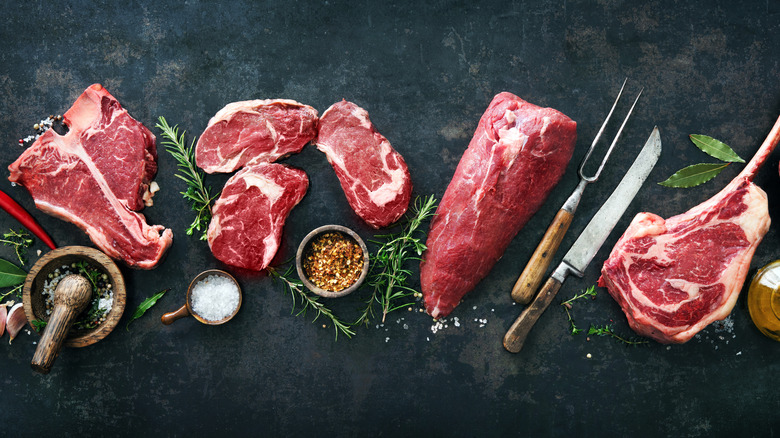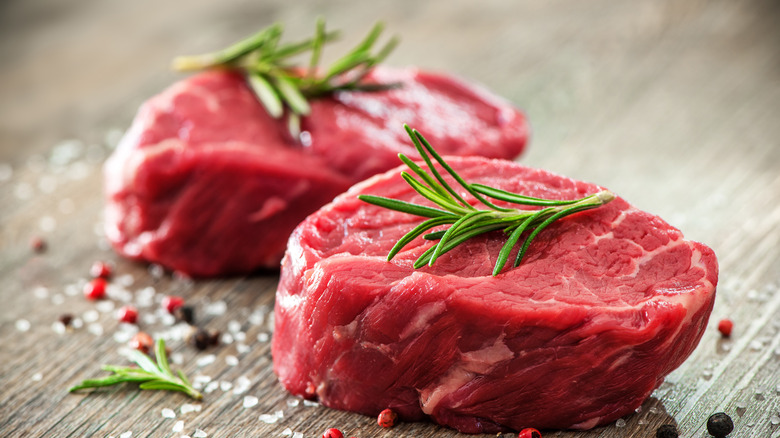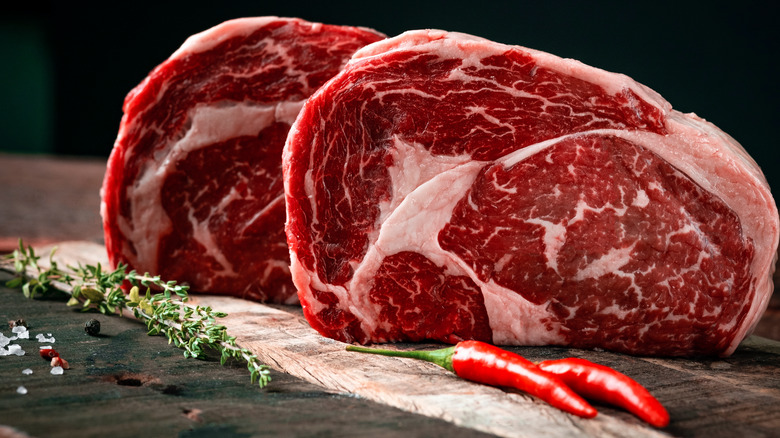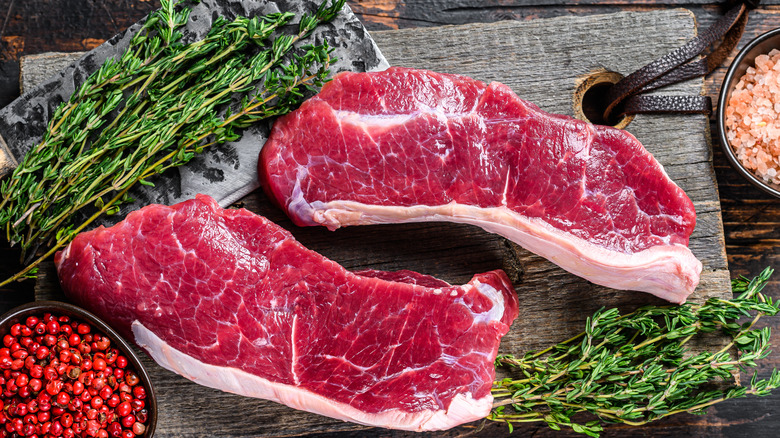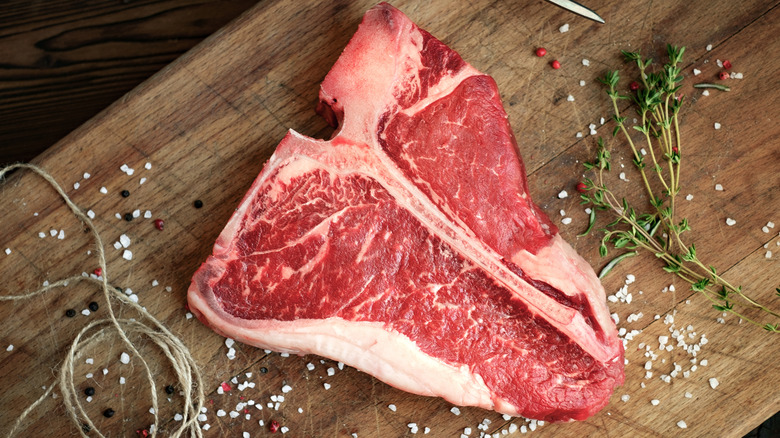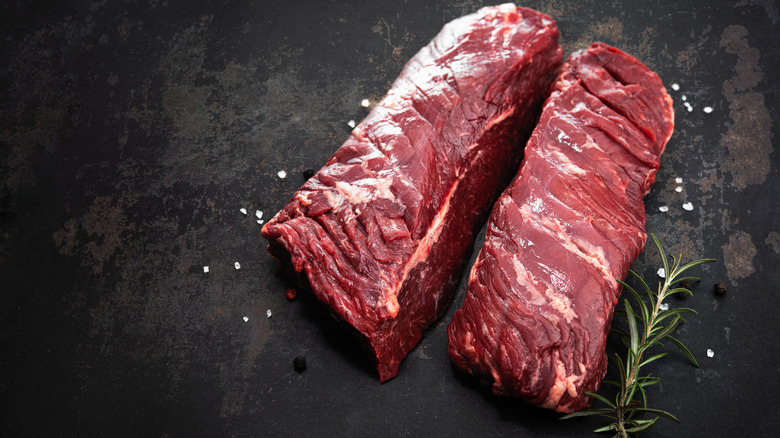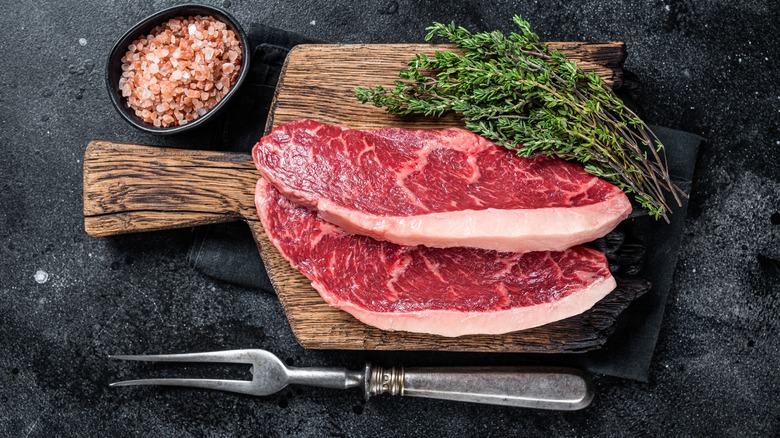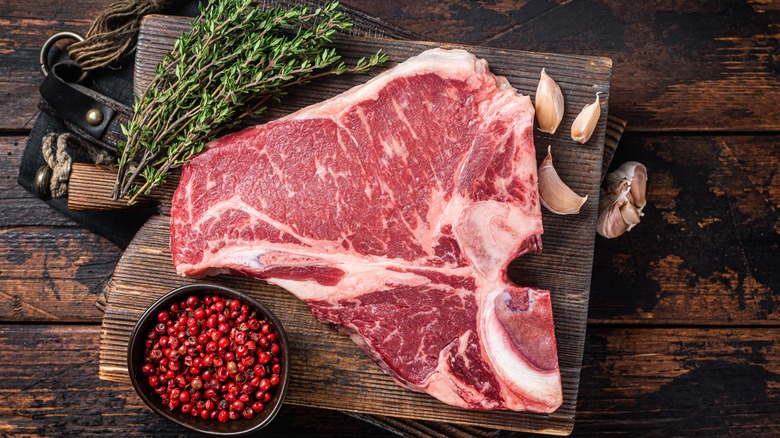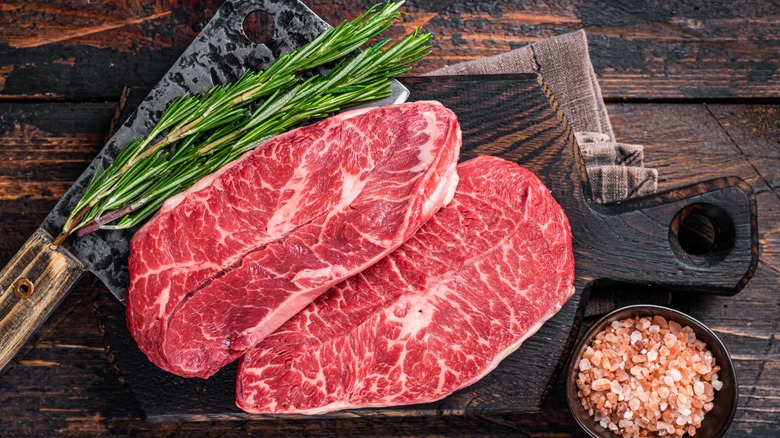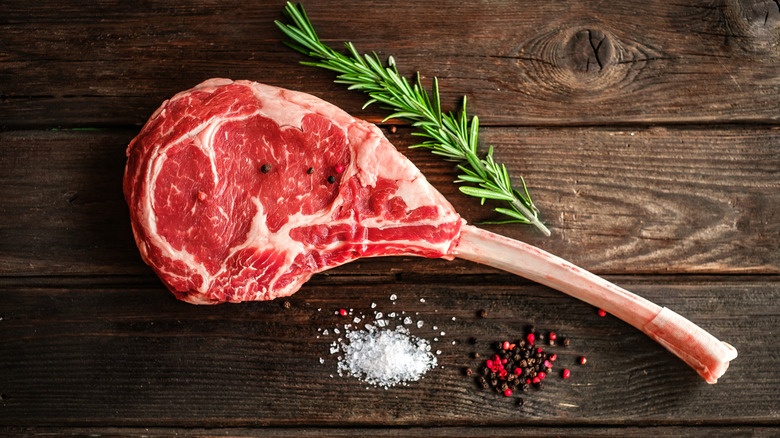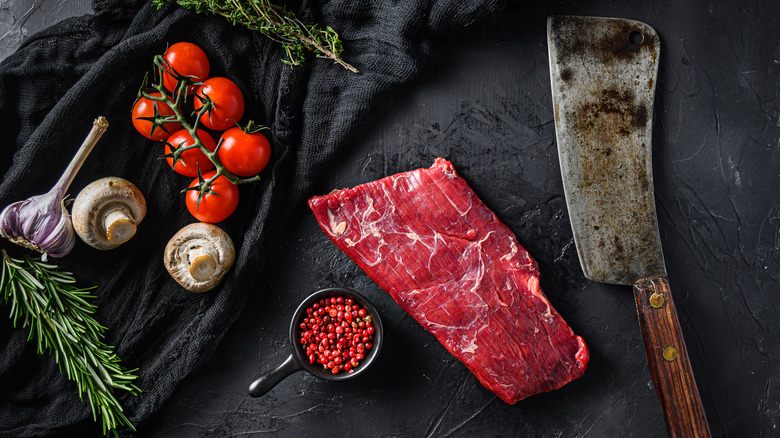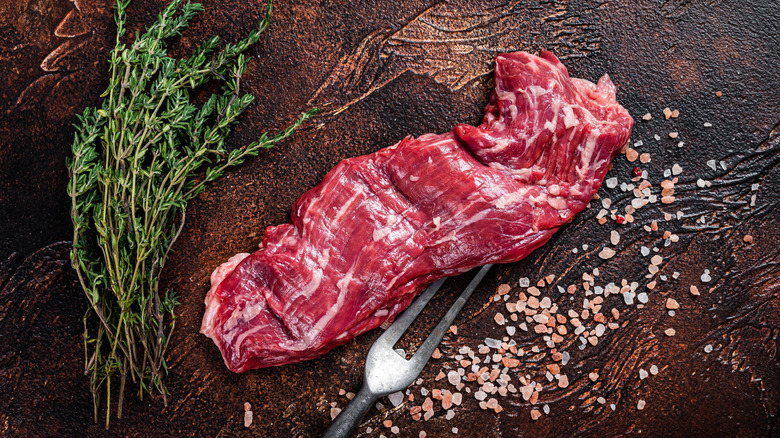The Best Cuts Of Steak And How To Cook Them
For the meat lovers among us, there is no better sound than the sizzle of a steak on the grill and the smoky scent that follows. Preparing the steak is as much a part of the fun as eating it. However, not all cuts of beef require the same treatment, and a misstep at the cooking stage can spell disaster for your dinner companions and your wallet.
Selecting a cut of meat can be overwhelming, and many people gravitate to the classics like striploin and ribeye. While these cuts are popular for a reason, there are many lesser-known steaks that also deliver excellent flavor and texture. Learning how to properly cook the best cuts of steak — including some hidden gems — will elevate your skills and overall meal experience.
Whether you're splurging on a T-bone or preparing a midweek flat iron, let's explore the cooking methods, marinades, and accompaniments that will guarantee a spectacular steak every time.
Filet mignon
If you are looking for the most tender cut of steak, filet mignon has to be top of your list. Cut from a section of the tenderloin near the ribs, filet mignon is an elegant cut of meat that melts in the mouth when prepared well. Literally meaning "delicate filet," this champion of cuts comes with a hefty price tag — it is one of the most expensive cuts available.
If you are splurging on filet mignon for a special meal or dinner party, you want to make sure you give it the best treatment possible and cook it to perfection. The good news is filet mignon is relatively easy to cook, as long as you keep a close eye and don't overcook it. This cut of steak will taste good served rare to medium-well, but chefs and steak lovers alike would recommend medium-rare as perfect.
To achieve a crispy exterior while perfectly cooked inside, pan-fry the filet first until the outside is brown before transferring it to a hot oven for five more minutes. If you are using a meat thermometer, around 130 degrees Fahrenheit is what you should be looking for.
Since filet mignon doesn't have the most robust beefy flavor, you will want to serve a strong sauce alongside it. A creamy pepper sauce or rich red wine jus will pair perfectly with the tender meat. If you are feeling particularly indulgent, try the French classic tournedos Rossini — filet mignon topped with foie gras and a velvety Madeira sauce.
Ribeye
Ribeye is considered by many in the steak community as the tastiest cut of beef you can find, thanks to the rich marbling of fat throughout. Generally taken from between the 6th and 12th ribs of the cow, the meat is tender since this part of the animal doesn't see much movement. This cut of beef is expensive, as preparing these steaks is time-consuming — but the flavor and texture make it worth paying a little more.
If you are used to having rare steaks, you may wish to cook a ribeye a bit longer than usual. The fat marbled throughout the meat will improve the flavor of the beef the longer it is cooked, meaning medium is usually the recommended temperature for a ribeye steak.
To cook the perfect ribeye, you want to caramelize the meat with the fat that comes out, so cooking it in the pan is a great way to do this. Cook for around three minutes on each side on a high heat, basting with the fat from the meat and some butter as it cooks. Don't forget to let the meat rest for around the same time it was cooked for. This will prevent the blood from spilling out when cutting into the steak.
Since the ribeye is a rich cut of meat, consider serving it with some simple sides such as asparagus and mushrooms. A high-tannin wine — Cabernet Sauvignon comes to mind — is a perfect choice to serve alongside a ribeye to cut through the fat.
Striploin
If you are in a quandary trying to choose between the tenderness of the filet mignon and the rich, beefy flavor of the ribeye, consider a striploin instead. Often referred to as a New York strip and known as sirloin outside the United States, it is cut from the short loin and is a steakhouse favorite. It's a premium cut of meat and comparable in price to a ribeye, though in most cases cheaper than a filet.
To get the most out of your striploin, cook it in a skillet to allow you to baste the meat with its own fat as it cooks. Though not as rich in marbling as a ribeye, the striploin has a reasonable amount of fat. You may wish to add a knob of butter and some herbs to the pan to create a light sauce for the meat to cook in. Cook the meat for three minutes on each side for a rare steak and four minutes each for medium. Another minute each side will give you a medium-well striploin, but be careful not to dry out the meat out.
Classic steakhouse sides such as fries and mushrooms make the perfect accompaniment to a striploin, or why not mix things up with creamy mashed cauliflower instead of the usual spuds? However you choose to serve it, the striploin is a quality cut of meat, so make sure you source it well, cook it to perfection, and savor every mouthful.
T-bone
For those times when you are feeling particularly indulgent — or indecisive — why not splurge on a T-bone steak? Comprising both the striploin and tenderloin, a T-bone gives you two prime cuts of steak in one deliciously hearty package.
With a prized cut like a T-bone, it is essential to get the cooking spot-on, which takes a little more skill than a boneless cut. T-bones were made for grilling, resulting in a perfectly charred outside with a juicy interior. Never cook your steak straight from the fridge, as this may result in uneven cooking – instead, let it come to room temperature before firing up the grill. After seasoning liberally with salt and pepper, place the steaks on the grill at the hottest point. Since T-bones tend to be cut thick, this steak will need longer on the grill than your average strip or ribeye. Think four minutes on each side for rare and at least a minute longer on each side for every level of doneness; remember to let rest for around 10 minutes.
When cooking steak on the bone, bear in mind that due to the bone being a poor conductor of heat, the meat nearest the bone will cook less than the rest of the steak. If you are cooking your meat to at least medium, this will result in a brilliantly juicy section of meat near the bone, but for those enjoying their T-bone rare (just fyi) you may end up with nearly-raw meat at the center.
Hanger
Known as "the butcher's cut" since it was the steak the butcher traditionally kept for himself, hanger steak is a lesser-known option that will give you a delicious steak for a much lower price than the most popular cuts. Make way, expensive filet and renowned ribeye; the underdog hanger steak is ready to step out of the shadows. Located near the kidneys, hanging from the diaphragm (hence the name), hanger steak has a strong flavor with hints of offal, making it a favored choice with beef connoisseurs. Also known as onglet, it is a popular choice in France but is often underused in many other countries.
Hanger steak benefits from a marinade, especially a citrus-based one that will start to break down the proteins and tenderize the meat. Aim for a perfect medium-rare for this cut since overcooking it even slightly will make it tough. Quick and hot is the way to go, either on the grill or in a skillet, for two to three minutes on each side or until the internal temperature is around 130 degrees Fahrenheit.
A deep red wine sauce will complement this rich meat perfectly, enhancing the meat's robust flavors. Pair with a similarly full-bodied wine to complete the meal — and discover exactly why the butcher didn't want to sell this cut!
Rump
Continuing our journey through the best (and in some cases underrated) cuts of beef, we find a steak whose name belies its culinary potential — the rump steak. As its less-than-glamourous name suggests, the rump is found at the rear of the cow, above the hind leg, and has a deep, beefy flavor since it comes from a well-used muscle.
Known as sirloin in the United States but rump elsewhere in the world, it's a popular cut in steakhouses, as it provides the flavor of striploin without the price tag. It's not as tender, though, so care needs to be taken when cooking to ensure the perfect texture. Medium-rare will give you the best result, especially if pan-fried with a little butter and some fresh herbs such as thyme and rosemary. A squeeze of lemon juice during cooking will help tenderize the meat and add a depth of flavor.
While this steak shines with just garlic butter and fries, as a leaner steak, you can afford to serve it with a rich side dish, such as potato dauphinoise or cauliflower cheese if you choose. Alternatively, earthy vegetables (parsnips or carrots anyone?) will provide a nice balance to the dish.
In the world of steak, rump is the unsung hero of flavor and value, delivering a deeply satisfying steak dinner without the usual expense. When cooked to perfection, it rightfully claims its place alongside beef royalty.
Porterhouse
Next on our list is the titan of steak — the porterhouse. Often wrongly considered to simply be a large T-bone, the porterhouse is actually a different cut that contains more of the tenderloin than its smaller cousin. Porterhouse steaks have to be at least 1.25 inches in thickness, making this a mammoth cut of beef that showcases both the striploin and filet on one plate.
With a prime porterhouse steak costing as much as $50 per pound, you definitely want to make sure you cook this steak well! While cooking on the grill or in a skillet are definitely options, broiling your porterhouse in the oven will allow you more control, helping make sure you don't overcook it. A medium-rare steak will need around 13 minutes under a broiler, plus at least five minutes of resting time afterward.
For a regal cut such as this, the accompaniments need to be up to the task, too. Pair it with a velvety garlic mash, creamed spinach, and a classic sauce such as peppercorn or bearnaise. When eating such a decadent meal, it is worth treating yourself to a top-notch bottle of wine. An Italian Barolo or French Cabernet Sauvignon will have enough acidity to match the richness of the meat.
In the culinary world, the experience of eating a porterhouse steak is unparalleled, especially among meat lovers. Such a dish, when prepared well, promises a dining experience that will live long in the memory and on the taste buds.
Flat iron
If you are seeking out a budget cut of beef that will still deliver on flavor and texture, there is a steak you may have overlooked. The flat iron steak is a cut that captivates the palate as well as the wallet, meaning a tasty steak could make its way into your weekly meal plan without breaking the bank. Named after its resemblance to an old-fashioned iron, flat iron steaks come from the shoulder area, the same place that chuck steak is cut from. However, while chuck is a tough meat that needs to be braised slowly to break down the protein, the flat iron can be cooked in the same way as a more premium cut of beef to create a tasty but economical meal.
Since flat iron steaks are thinner than other cuts, they will cook more quickly, so be careful to avoid overcooking. Flash fry in the pan for a few minutes on either side to achieve a perfect medium-rare, then rest for five minutes to allow the juices to reabsorb.
The low price of flat iron steak makes it perfect for adding to dishes where other cuts would be cost-prohibitive. From fajitas to stir-fries and salads to sandwiches, this cut of meat allows you to take these everyday dishes up a notch. By introducing flat iron steak into your repertoire, you can have gourmet meals regularly without having to overshoot your budget.
Tomahawk
In a search for the most visually dramatic steak, the tomahawk would surely take first place. This majestic steak is cut from the rib and includes a long, French-trimmed bone, allowing you to grasp the steak and eat it in the most primal fashion, should you wish. Getting its name from its resemblance to a tomahawk axe, this prized cut has all the marbling and delicious flavor of a ribeye, with the added spectacle of the mammoth bone. The same cut without the lengthy bone is known instead as a cowboy steak.
While the tomahawk can be cooked entirely on the grill, a piece of meat this size and quality would benefit from a two-step cooking method. First, cook the steak for two to three minutes on each side, either in a skillet or on the grill, then transfer to a hot oven for around 15 to 20 minutes for a rare to medium-rare steak. Rest for 10 minutes before serving.
For such an imposing cut of beef, you may wish to consider lighter options as side dishes. A simple salad with blue cheese dressing would provide a refreshing savory accompaniment, while some steamed vegetables such as asparagus or broccoli add earthiness to the dish. When serving a tomahawk steak, the meat is undoubtedly the star, so concentrate on cooking it well and let the magnificent beef speak for itself.
Flank
Flank steak is a cut often overshadowed by its trendier counterparts, but it has enough flavor and tenderness to deserve its chance to shine. This lean cut of meat comes from the underbelly of the cow. Although it contains some connective tissue, a well-cooked piece of flank should still be tender. It is a much more popular cut in France than it is in the United States, and it is commonly used in the famous steak frites.
To prevent flank steak from drying out, cook it quickly on the grill or in a pan, and aim for medium-rare. Marinating the meat for at least 30 minutes beforehand will help keep it tender and add depth of flavor. Cook for six to seven minutes on each side, then slice against the grain to shorten the long muscle fibers and keep the steak tender.
The deep flavor of flank steak can cope with a strong-tasting sauce, so consider topping it with something zesty like a chimichurri. While flank steak needs a bit more attention to detail than some other cuts, it is worth the effort for its deliciously beefy flavor. Your taste buds and your wallet will thank you for adding flank to your list of go-to cuts of steak.
Skirt
Often thought to be the same cut of meat as flank, skirt steak is another affordable option that has a great beefy flavor. Skirt steak consists of the outside and inside skirt, but the outside skirt is rarely available in grocery stores, so the inside skirt will likely be the cut you will buy.
The inside skirt is cut from below the rib and has plenty of marbling, which translates into lots of flavor. It is a long, thin cut that benefits from quick cooking to a doneness of no more than medium. Cooking it for longer will result in a tough piece of meat. Like flank steak, skirt steak does really well with a marinade, which can lift its flavor as well as tenderize the meat. A vinegar and soy sauce marinade will work perfectly, as the acid will begin to break down the protein prior to cooking. Throw the steaks on the grill for two to three minutes on each side for a perfect medium-rare.
Due to the economical price and quick cooking of skirt steak, it is the perfect cut for a weekday meal such as fajitas or tacos. A squeeze of fresh lime and a sprinkling of cilantro will create a light, refreshing meal that will keep the whole family happy.

